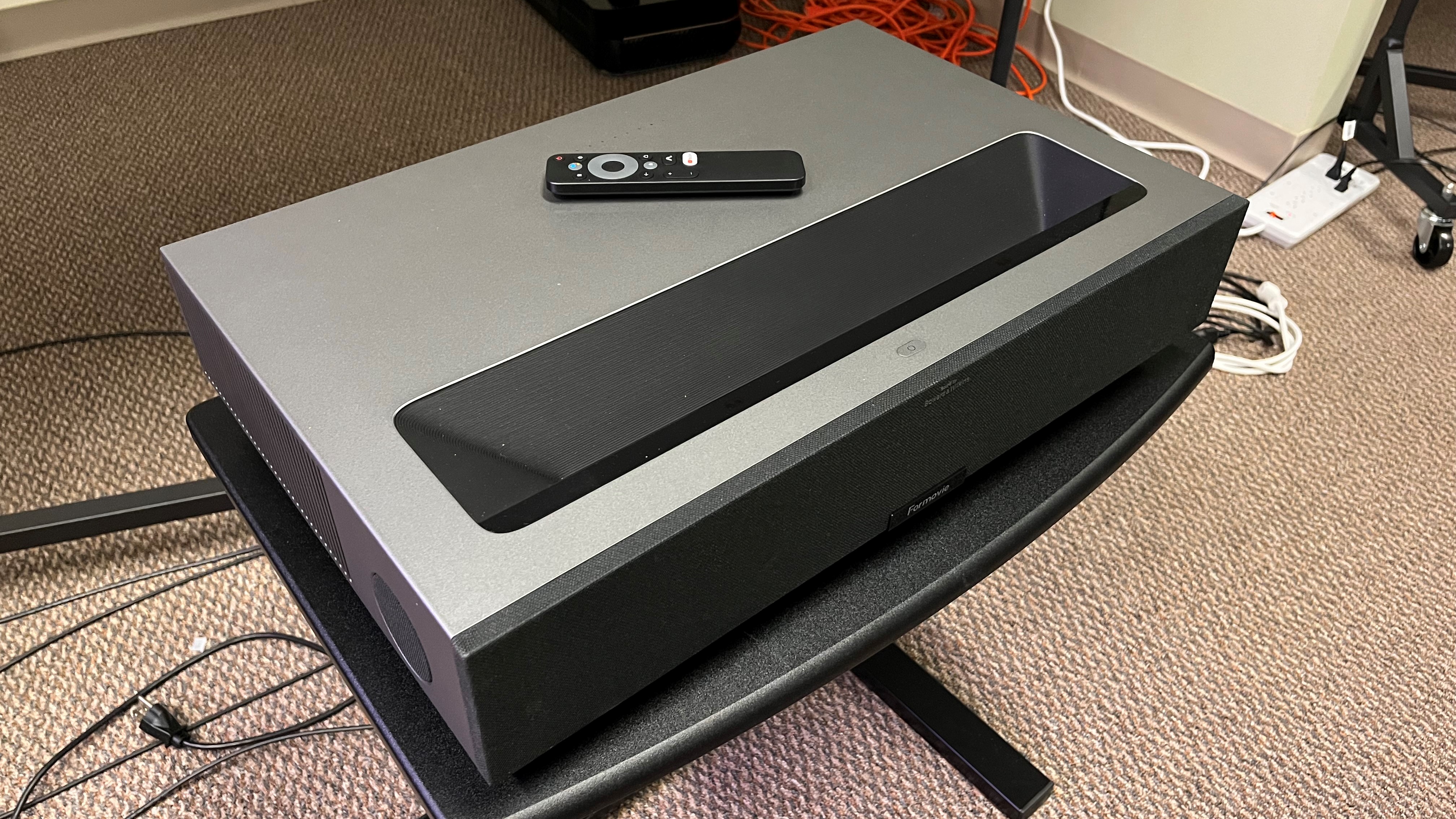Early Verdict
The Formovie Theater is an affordable 4K ultra short throw projector offering better overall performance than its pricier competition. With a great-sounding built-in Bowers & Wilkins audio system and Android TV smart interface for streaming, the Theater is an all-in-one A/V system – just add a screen and you have a home cinema.
Pros
- +
Bright images with strong contrast
- +
Rich color and accurate skintones
- +
Excellent built-in Bowers & Wilkins audio system
Cons
- -
Doesn’t tone map high brightness HDR images as well as competition
Why you can trust TechRadar
The Theater is a tri-laser ultra short throw (UST) 4K projector sold by Formovie, a joint venture between Xiaomi Technology and Appotronics, a company that makes the light engines used in many laser-based projectors worldwide. Formovie’s UST has received well-deserved buzz for being one of the first projectors with Dolby Vision support, so I was eager to see it in action at the 2022 Laser TV Showdown I recently participated in as a judge, and to get a sense of how it held up against the best 4K projectors.
Following the Showdown, which was a group test of 14 single- and tri-laser projectors, I was given the opportunity by event sponsor ProjectorScreen.com to do a hands-on review of the Theater, a model that was judged to be the best all-around performer in the tri-laser category. It also gave me a chance to check out the Theater’s built-in Bowers & Wilkins audio system, a premium feature that surprisingly doesn’t jack up its price.
To see what a regular viewer would experience with the Formovie Theater straight out of the box, I made a point of doing a reset of the picture settings used earlier in the group test. The video source used for my hands-on evaluation was 4K Blu-rays played on an Oppo UDP-103 Ultra HD Blu-ray player.
Price and availability
The Formovie Theater is sold for $2,999 in the US from ProjectorScreen.com, the unit’s sole US distributor, and is also available for pre-order directly from Formovie’s website. While the fact that one of the Shootout’s winning projectors was sold exclusively in the US by the event’s host initially tweaked me somewhat, getting to do a personal hands-on review helped put my mind at ease about the situation.

Design and features
The Theater has a dark gray case and a basic design that doesn’t draw attention to itself – a good thing for a UST projector in my opinion. A darker gray mesh material conceals its front firing speakers. Along with LED indicator lights that fire up when accessing menus, there are both Formovie and Sound by Bowers & Wilkins logos located on the projector’s face, along with additional speaker grilles located on the left and right sides.
As a tri-laser design with individual lasers used to create the red, green, and blue components of color images, the Theater is spec’d for 107% BT.2020 color gamut coverage, and 2,800 ANSI lumens brightness. Image size ranges from 80 to 150 inches, though for my test I used a Spectra Projection Vantage 100-inch 0.5 gain ambient and ceiling light rejecting screen.
Along with Dolby Vision HDR, the Theater has Dolby Atmos support, and its Bowers & Wilkins audio system uses four total speakers to deliver Atmos sound. You can select various sound modes other than Atmos, though I kept that one active for my full evaluation.
Sign up for breaking news, reviews, opinion, top tech deals, and more.

The projector features the Android TV 11.0 smart TV platform and can stream from apps including HBO Max, Hulu, YouTube, and Disney +. It has Chromecast built-in for wireless casting from a phone, tablet, or laptop, and also comes with a compact remote control with a basic button layout, including one to trigger the projector’s Google Assistant voice control. That last feature can also be accessed via the Theater’s built-in far-field microphone by saying “Hey Google.”
Three HDMI inputs are located on the projector’s back panel, including one with eARC. It also supports Auto Low Latency mode, though the measured (by event organizer Projector Central) 41.9ms input lag time makes it a just-average choice for gaming. Other connections include optical digital and mini-jack analog audio plus a LAN port.

Performance
The Theater provides multiple picture modes and its video adjustments include a color management system that allows it to be calibrated for accurate color. That ability doubtless gave it an edge over some other projectors in the Showdown with less advanced picture settings, but the Formovie projector also produced images with natural-looking colors and precise gamma with just its Movie mode selected.
Watching the movie Oblivion, the Theater displayed accurate skin tones, and the image had a punchy quality that indicated it had a good contrast ratio. Detail was excellent and there were no signs of automatic enhancement in Movie mode that made pictures look unnaturally crisp.
The same qualities carried over when I watched It, a movie with Dolby Vision HDR. (When a Dolby Vision source is detected, the Theater displays a logo on-screen to let you know you’re getting the real thing.) Shadows in the early scene in the slaughterhouse had good depth and detail, and later shots showed an impressive range of period-specific colors in the movie’s sets.
Switching over to the video montage section of the Spears & Munsil Ultra HD HDR test disc, blacks in images used as a torture-test for contrast were a relatively pure black, and colors in shots of cactus flowers and butterflies looked rich and showed a wide range of subtle hues. Images of clouds transferred at 4,000 nits used to test HDR tone mapping demonstrated that the Theater was doing a good job on this front, though it was one of the lower-scoring projectors on that specific parameter in the official Showdown.

Audio quality
Given the Theater’s built-in Bowers & Wilkins speakers and Atmos support, audio performance was obviously high on my list of things to check out.
Watching scenes from Oblivion where a ship zooms across the sky, the sound coming from the Theater was clean and distortion-free. In my experience, that’s something you can easily say about the best soundbars, but definitely not the built-in audio systems of UST projectors. Dialogue was clear and voices had good depth and body. There was also a sense of the sound extending out to the left and right beyond the physical dimensions of the projector: those side-facing speakers at work.

Switching over to It, that movie’s dramatic and fear-inducing soundtrack had a fully dynamic quality. I wouldn’t say I was hearing overhead Atmos effects, but the audio coming from the projector was tall and wide enough to make it an equal match for the 100-inch screen. There wasn’t much in the way of bass – not exactly a surprise for an audio system built into a compact projector. But the bass the system did manage blended well with the rest of the sound, and I didn’t hear any booming or vibration of the projector’s case.
Bottom line: most viewers will be happy with the performance of the Theater’s built-in audio, which well exceeds that of other UST projectors I’ve handled.

Early verdict
The Formovie Theater’s sleek design and bright, living room friendly image makes it a good choice for watching TV in a relatively well-lit room. And when you turn off the lights for movie viewing, its punchy contrast and very good shadow detail will do the best discs and streams justice.
All of that is enough to make the Theater an easy ultra short throw recommendation, but the addition of a built-in Bowers & Wilkins Atmos audio system that can play relatively loud and still sound clean while providing a good semblance of surround makes it something of a slam dunk. I look forward to eventually getting in a unit for a full review, but from the time I’ve already spent with the Theater, I can confidently claim to be impressed.

Al Griffin has been writing about and reviewing A/V tech since the days LaserDiscs roamed the earth, and was previously the editor of Sound & Vision magazine.
When not reviewing the latest and greatest gear or watching movies at home, he can usually be found out and about on a bike.
